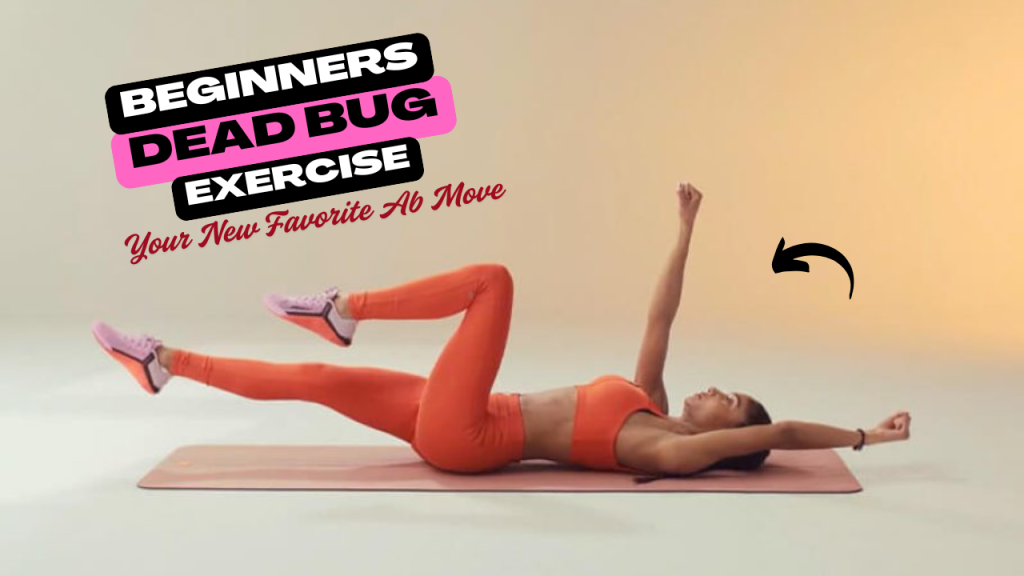Ever wonder why your core workouts aren’t delivering results despite all the crunches and planks? You might be skipping one of the most underrated yet powerful exercises for deep abdominal strength—the Dead Bug. This quirky-named move isn’t just beginner-friendly—it could become your secret weapon for a stronger, more stable core.

What Happens After 30 Days of Doing the Dead Bug Exercise
| Benefit | What You May Notice |
|---|---|
| Improved Core Strength | Better control over your abdominal muscles and easier core engagement in daily activities. |
| Reduced Lower Back Discomfort | Decreased back stiffness or pain, especially if you previously had poor core support. |
| Better Posture | You’ll naturally sit and stand taller as deep stabilizer muscles get stronger. |
| Enhanced Coordination | Greater ease in performing opposite limb movements and full-body exercises. |
| Increased Mind-Muscle Connection | More awareness of your body and how to properly engage your core during other workouts. |
| Flatter Midsection Appearance | Improved muscle tone in the abs, making your waistline appear tighter (when paired with healthy nutrition). |
| Stronger Pelvic Stability | Easier time with balance-based movements and even reduced risk of injury during workouts or daily life. |
| Better Breathing Mechanics | Easier, deeper breathing as the diaphragm and core muscles work in harmony. |
Dead Bug Exercise: Do’s and Don’ts
| Do’s | Don’ts |
|---|---|
| Keep your lower back flat on the floor | Arch your lower back during the movement |
| Move slowly and with control | Rush through the reps |
| Breathe steadily (exhale as you extend, inhale as you return) | Hold your breath while performing the exercise |
| Engage your core throughout | Let your core relax mid-rep |
| Start with smaller movements if you’re new | Extend limbs fully if you lack core strength or control |
| Focus on quality over quantity | Aim for high reps with poor form |
| Relax your neck and shoulders | Tense your neck or lift your head unnecessarily |
| Use a mat for back support if needed | Perform on a hard surface without support |
| Modify the move to match your level | Jump into advanced versions too soon |
| Listen to your body and stop if you feel pain | Push through pain or discomfort |
What Is the Dead Bug Exercise?
Despite its odd name, the Dead Bug exercise is a scientifically backed, physical therapist-approved core exercise. It mimics the movement of a bug lying on its back with arms and legs in the air, hence the name. But don’t be fooled—this isn’t just a fun visual. The Dead Bug targets your deep core muscles, especially the transverse abdominis, while teaching coordination and spinal stability.
Unlike crunches or sit-ups, the Dead Bug keeps your spine in a neutral position, making it safe for your back while still strengthening your core.
Why Beginners Love the Dead Bug Exercise
Low-Impact, High-Reward
The Dead Bug doesn’t strain your neck or spine. It’s easy on the joints but tough on the abs, making it ideal for beginners, seniors, and even those rehabbing from injuries.
Improves Core Stability
This move teaches your core to stabilize your spine while your limbs move—essential for real-life movements like walking, lifting, or even getting out of bed.
Corrects Muscle Imbalances
The Dead Bug activates not just the abs but also the hips, lower back, and shoulders. If you tend to overuse certain muscles during workouts, this can help retrain your body to move better.
Enhances Mind-Muscle Connection
Because it’s a slow, controlled movement, you’re forced to stay mentally engaged, helping you learn proper form and body mechanics.
How to Do the Dead Bug Exercise (Step-by-Step)

Starting Position:
- Lie on your back with your knees bent at 90 degrees, stacked above your hips.
- Raise your arms straight up toward the ceiling.
- Engage your core and flatten your lower back into the floor (posterior pelvic tilt).
Movement:
- Slowly lower your right arm and left leg toward the ground at the same time. Keep both about an inch from the floor.
- Maintain core engagement and avoid arching your lower back.
- Return to the starting position and switch sides.
- Repeat for 8–12 controlled reps per side.
Pro Tip:
Breathe steadily. Exhale as you extend the limbs, and inhale as you return.
Do You Know?
Dead Bug exercises are often prescribed in physical therapy to treat lower back pain. That’s because it strengthens the deep core muscles that support your lumbar spine—a major culprit in chronic pain.
Modifications & Progressions
➤ Make It Easier:
- Tap one heel to the ground instead of fully extending the leg.
- Keep your arms still and just move your legs.
➤ Make It Harder:
- Hold a light dumbbell or medicine ball between your hands.
- Add ankle weights or resistance bands for an extra challenge.
- Try performing the move on a stability ball or foam mat for extra core engagement.
Interesting Fact:
Dead Bug isn’t just for abs. Studies have shown that it helps improve neuromuscular control, which means better balance, reaction time, and reduced injury risk—especially in athletes.
Myth Buster: “You need to feel the burn for it to work.”
Not true. Dead Bug isn’t about burning out your abs—it’s about activating deep muscles that stabilize your entire torso. That “burn” from crunches is often superficial and doesn’t target these deeper muscles.
How Often Should You Do It?
Aim for 3–4 sets, 2–3 times per week, especially as part of a full-body warm-up or cool-down. As your strength and control improve, you can incorporate advanced variations.
Why It’s Your New Favorite Ab Move
In a fitness world obsessed with six-packs, it’s easy to forget that a strong core isn’t just for looks—it’s for life. The Dead Bug stands out because it:
- Trains real-world strength, not just aesthetics
- Is scalable for any fitness level
- Supports posture, balance, and coordination
- Can be done anywhere, no equipment is needed
Final Thoughts
The Dead Bug might look simple but don’t underestimate its power. It teaches you to control your body from the inside out—something crunches and sit-ups rarely achieve. If you’re serious about building a resilient core and avoiding injury, it’s time to make the Dead Bug your go-to ab move.
Frequently Asked Questions (FAQs)
Is the Dead Bug exercise good for lower back pain?
Yes. The Dead Bug is often recommended by physical therapists for individuals with lower back pain. It strengthens the deep core muscles that stabilize the spine, reducing stress on the lower back and improving posture.
Can I do the Dead Bug exercise every day?
You can do it daily, especially if you’re focusing on improving core activation and spinal stability. However, for best results and muscle recovery, 3–4 times per week is typically sufficient.
Do I need equipment to perform the Dead Bug exercise?
No equipment is necessary for the basic version. However, you can add dumbbells, resistance bands, or a stability ball to increase difficulty as you progress.
Is this exercise suitable for seniors or people with limited mobility?
Yes, the Dead Bug is low-impact and easily modified, making it ideal for seniors or beginners. Start with limited limb movement and increase the range of motion gradually.
How long should I hold each rep?
Each rep should be slow and controlled, lasting around 4–6 seconds—2–3 seconds to extend, 2–3 seconds to return. Quality matters more than speed.
What should I feel working during the Dead Bug?
You should primarily feel your deep core muscles (transverse abdominis and lower abs). If you feel tension in your neck or lower back, reassess your form and core engagement.
Can Dead Bug exercises help flatten my stomach?
While no single exercise can spot-reduce fat, Dead Bugs strengthen the core muscles that contribute to better posture and abdominal tone. When combined with proper nutrition and overall fitness, it can support a flatter midsection.
What’s the difference between Dead Bug and crunches?
Crunches mainly target the rectus abdominis (six-pack muscles) and can strain the neck and spine. Dead Bugs engage the entire core, including stabilizers, and are performed with the spine in a neutral, safe position.
Who should avoid the Dead Bug exercise?
Most people can safely perform the Dead Bug, but individuals with severe spinal issues, recent abdominal surgeries, or balance disorders should consult a healthcare professional before starting.





